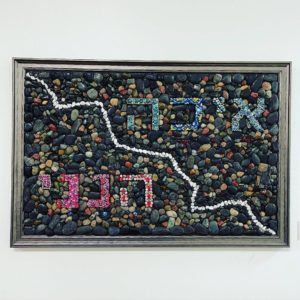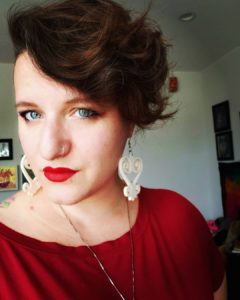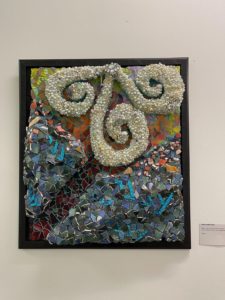
Beauty may be in the eye of the beholder, but for Rabbi Gila Ruskin, she hopes the beholder sees more than just beauty in her mosaic art.
The West Philadelphia-based rabbi and artist, with 15 years of mosaic-making under her belt, created the project Mosaic Midrash hoping others would help add meaning to her pieces, which were inspired by the words of the Torah.
Combining meticulously placed tiles traditionally seen in the mosaic medium with three-dimensional elements from found objects, Ruskin constructs her mosaic pieces drawing not just on the materials of everyday life, but also the theme of what it means to be alive.
“I love the idea of taking broken objects, constructing them into something beautiful. To me, that’s the essence of life,” Ruskin said.
Audiences can view and participate in Ruskin’s Mosaic Midrash project by visiting her exhibit, which opened Feb. 27, at Mekor Habracha/Center City Synagogue, 1500 Walnut St., #206.
The exhibit consists of 35 mosaic pieces, almost all of them drawing inspiration from a scene from the Torah. The exhibit is interactive, with visitors able to affix materials to some pieces, and add their own midrashic interpretations to the works.

Divided into three separate themes, the exhibit is a loose exploration of one’s life and their connection with God, according to curator Seraphina Ferraro.
The first theme is Mavo, which Ferraro described as “the chaos before divine order.” The theme is represented in pieces such as “Midrash of the Arks,” which has become a hotbed for interpretation in the exhibit. Instead of one ark represented in the piece, there are nine, and Ruskin asks her viewer why this is.
Among the responses she’s received, Ruskin has been stunned by the diversity in thought the pieces have evoked.
“One person said it’s so the animals don’t ever give up hope; they can always see that there’s another art coming along, and that they don’t have to despair,” she said of one interpretation.
The second theme is M’orav, involvement, which represents the human covenant with God and the intertwining of spiritual values and practices in Jewish life.
The last theme is Matmid, which focuses on the idea of the promises of the future one keeps with God, and includes a piece she created several years ago about the Red Cross refusing to collect blood donations from Black Americans in 1941.
“What I love about Gila and about the way that she approaches her work is that she really wants that moment when the rubber meets the road, of her artwork and her concepts, meeting other people and creating new stories, new ideas,” Ferraro said.
Ruskin was inspired to display her artwork in this fashion after visiting Mekor Habracha and being struck by the lighting in the space’s hallway.
Mekor Habracha Rabbi Eliezer Hirsch, who is a proponent for hosting art at the synagogue space, thought Ruskin’s works reflected the synagogue’s values of using art to augment the aesthetics of the space and could “inspire” those who walked through the synagogue doors.
“The work of an artist is something personal, but it’s also something that they share with the community,” he said.
Ruskin was first drawn to mosaics because of her interest in creating picture frames and challah trays. When she taught a class on Genesis and asked her students to interpret two different images about the binding of Isaac, she realized the power of art in conveying various meanings to a narrative.
“That struck me in the moment that visual art could be a midrash and without words, they convey completely different conceptions of the same thing or multiple conceptions,” Ruskin said.
Though once a rabbi at a Reform congregation in Baltimore, Ruskin now produces art out of her condominium. Displaying her art at an Orthodox synagogue was important to her, as it allowed a new audience to give life to her mosaic pieces.
“Having a Hebrew-literate and biblically literate congregation to interact with it, to really grapple with these texts and these pieces of art, to me was what I wanted,” Ruskin said. “I ran after it; I pursued it.”
The exhibit at Mekor Habracha will be open to guests weekdays from 8 a.m. to 8 p.m. Some pieces will be available to buy.



